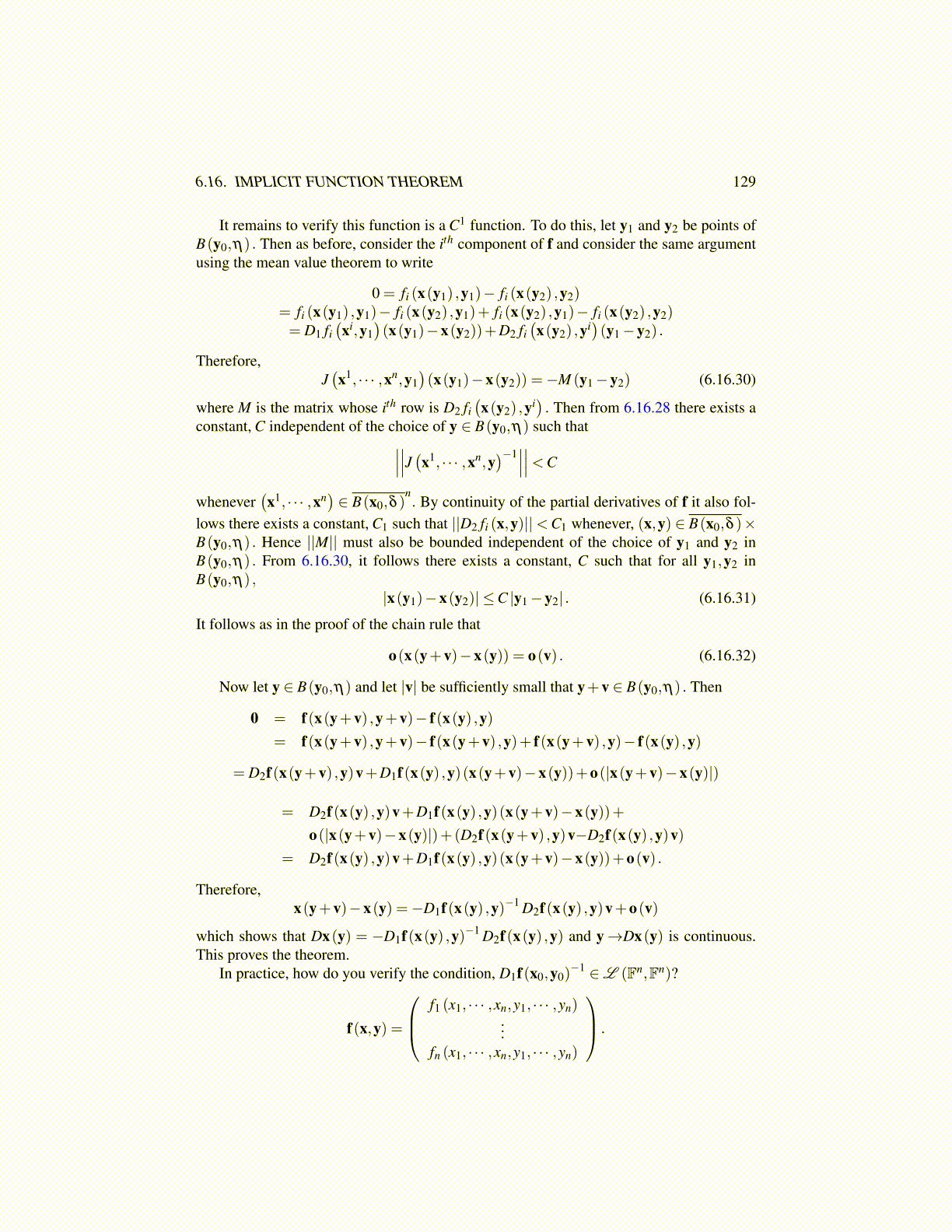
6.16. IMPLICIT FUNCTION THEOREM 129
It remains to verify this function is a C1 function. To do this, let y1 and y2 be points ofB(y0,η) . Then as before, consider the ith component of f and consider the same argumentusing the mean value theorem to write
0 = fi (x(y1) ,y1)− fi (x(y2) ,y2)= fi (x(y1) ,y1)− fi (x(y2) ,y1)+ fi (x(y2) ,y1)− fi (x(y2) ,y2)= D1 fi
(xi,y1
)(x(y1)−x(y2))+D2 fi
(x(y2) ,yi
)(y1−y2) .
Therefore,J(x1, · · · ,xn,y1
)(x(y1)−x(y2)) =−M (y1−y2) (6.16.30)
where M is the matrix whose ith row is D2 fi(x(y2) ,yi
). Then from 6.16.28 there exists a
constant, C independent of the choice of y ∈ B(y0,η) such that∣∣∣∣∣∣J (x1, · · · ,xn,y)−1∣∣∣∣∣∣<C
whenever(x1, · · · ,xn
)∈ B(x0,δ )
n. By continuity of the partial derivatives of f it also fol-
lows there exists a constant, C1 such that ||D2 fi (x,y)||<C1 whenever, (x,y) ∈ B(x0,δ )×B(y0,η) . Hence ||M|| must also be bounded independent of the choice of y1 and y2 inB(y0,η) . From 6.16.30, it follows there exists a constant, C such that for all y1,y2 inB(y0,η) ,
|x(y1)−x(y2)| ≤C |y1−y2| . (6.16.31)
It follows as in the proof of the chain rule that
o(x(y+v)−x(y)) = o(v) . (6.16.32)
Now let y ∈ B(y0,η) and let |v| be sufficiently small that y+v ∈ B(y0,η) . Then
0 = f(x(y+v) ,y+v)− f(x(y) ,y)= f(x(y+v) ,y+v)− f(x(y+v) ,y)+ f(x(y+v) ,y)− f(x(y) ,y)
= D2f(x(y+v) ,y)v+D1f(x(y) ,y)(x(y+v)−x(y))+o(|x(y+v)−x(y)|)
= D2f(x(y) ,y)v+D1f(x(y) ,y)(x(y+v)−x(y))+o(|x(y+v)−x(y)|)+(D2f(x(y+v) ,y)v−D2f(x(y) ,y)v)
= D2f(x(y) ,y)v+D1f(x(y) ,y)(x(y+v)−x(y))+o(v) .
Therefore,x(y+v)−x(y) =−D1f(x(y) ,y)−1 D2f(x(y) ,y)v+o(v)
which shows that Dx(y) = −D1f(x(y) ,y)−1 D2f(x(y) ,y) and y→Dx(y) is continuous.This proves the theorem.
In practice, how do you verify the condition, D1f(x0,y0)−1 ∈L (Fn,Fn)?
f(x,y) =
f1 (x1, · · · ,xn,y1, · · · ,yn)...
fn (x1, · · · ,xn,y1, · · · ,yn)
.